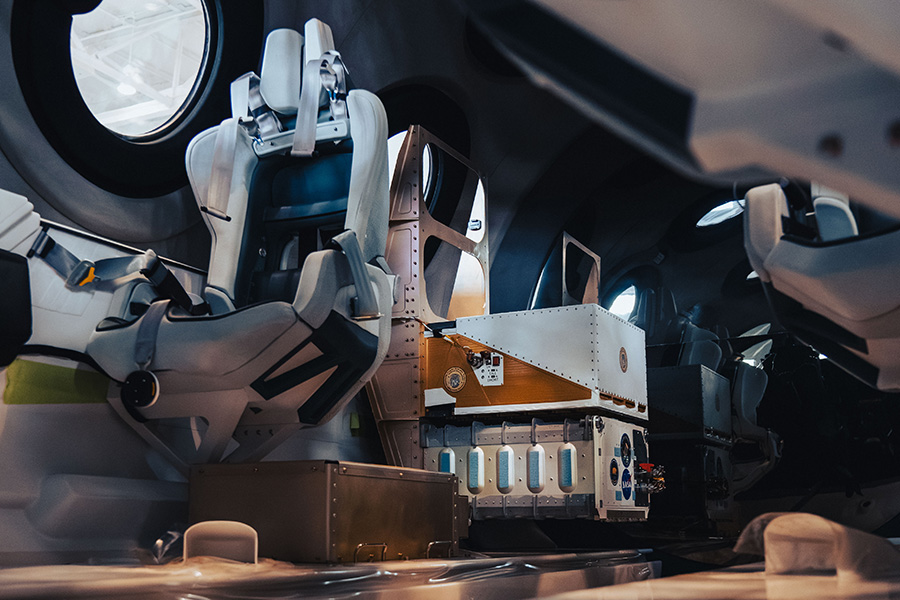Purdue advancements take strong presence in AIAA Aerospace America's Year in Review
Aerospace America’s annual Year in Review issue is a showcase of technological breakthroughs across the aerospace industry, as seen by the American Institute of Aeronautics and Astronautics (AIAA). For 2024, the publication highlighted several important research outcomes from Purdue’s College of Engineering. Those sections are excerpted below.
Propulsion and Energy

Updated standards for explosive devices and other breakthroughs
In July, Purdue University presented research on energetic processing methods at the International Pyrotechnic Society Seminar. The researchers observed the flow of surrogate powders via high-speed camera as a function of motor voltage and nozzle size. Understanding the role these factors play on the dynamics of powder flow is critical to ensure high-precision deposition. They also developed and characterized a new method for making a molding powder, with 90% sugar by weight using hydroxyl-terminated polybutadiene. This new processing approach could be a much faster method to tune the properties of plastic-bonded explosives.
Advances reported in detonation-based systems and solid-fuel scramjets
In rotating detonation rocket engines, injecting rocket propellants in both gaseous and liquid phases offers a wide array of choices. Liquid/liquid injection systems provide the highest theoretical advantage but operate at the most arduous conditions. In August, Purdue University researchers described their investigation of cryogenic systems with direct injection of liquid oxygen with kerosene or cryogenic methane fuels. Their work on these propellant combinations, published in JPP, resulted in successful detonation of both fuels.
Space and Missiles

Embarking on a new decade of space exploration research
Under the NASA Flight Opportunities Program, a rotational slosh experiment from Purdue University was flown onboard Virgin Galactic’s VSS Unity spaceplane. This experiment analyzed the rate of damping of propellant motion after a rotational spacecraft maneuver.
Missile defense industry takes steps to meet modern demands
The U.S. Navy in April and June awarded contracts to startups Xbow, Ursa Major and Anduril Industries to develop solid rocket motors. […] Anduril added SRM technology to its portfolio last year with its purchase of Adranos, a Purdue-affiliated startup.
Rotating detonation designs make progress on multiple continents
In March, researchers at Purdue University of Indiana and Spectral Energies of Ohio demonstrated megahertz-rate heat-flux measurements in a hydrogen-air RDE via an atomic layer thermopile. They compared their results to numerical predictions of local transient heat fluxes previously conducted at North Carolina State University.
In February, with NASA’s Glenn Research Center in Ohio, the Purdue and Spectral team investigated liquid injection in RDEs and captured the first million-frames-per-second volumetric fluorescence images of detonation-spray interactions. In May, they demonstrated phase Doppler interferometry for the first time within the RDE. The observed drop size distributions suggested substantial breakup and atomization of liquid jets.
Aerospace Sciences
Advances in high-speed optical diagnostics help characterize airflows from subsonic to hypersonic speeds
Researchers at the Boeing/Air Force Office of Scientific Research Mach-6 Quiet Tunnel at Purdue demonstrated two-photon laser-induced fluorescence measurements of carbon monoxide at rates faster than 1 kHz. They pushed the state-of-the-art by two orders of magnitude, to 100 kHz.
Sandia National Labs measured nitric oxide temperature via laser absorption spectroscopy, a technique developed in conjunction with Purdue University of Indiana. […]This was the most extensive characterization of shock tunnel flow ever performed, and researchers are referencing the measurements in their creation of models in hypersonic computational fluid dynamics codes.
Measuring, simulating, predicting and controlling fluid motion
In March, Purdue University researchers in Indiana completed a test campaign in which they raised the maximum quiet Reynolds number in the Boeing/Air Force Office of Scientific Research Mach 6 Quiet Tunnel to 21×10 m–¹. This is a world record for hypersonic low-disturbance tunnels, up from 15×10 m–¹ in 2022. This breakthrough enables the study of hypersonic turbulence under low-disturbance conditions, which the team demonstrated by observing natural transition on boundary layer transition geometry, with transition Reynolds numbers similar to those seen in the BOLT-II flight test in 2022.
